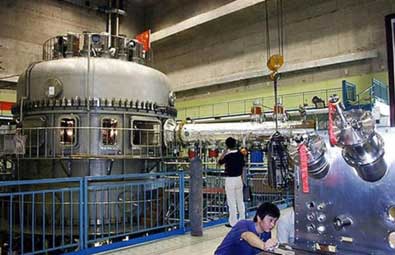The Chinese are committed to a new fleet of nuclear fission reactors. They are also putting money into a variety of other energy sources including nuclear fusion. Their Experimental Advanced Superconducting Tokamak (EAST) began operations in 2006 at the Hefei Institutes of Physical Science of the Chinese Academy of Sciences (CASHIPS). It is classified as an “open test facility” for carrying out steady-state operations and other research related to the ITEM project being developed in France. Both Chinese and scientists from other countries are able to the EAST.
EAST us a tokamak reactor. It contains a metal torus or donut shaped chamber. Air is pumped out until the torus contains what is called a “hard” vacuum. Hydrogen atoms are injected into the torus and heat by a variety of different methods. The resulting plasma is compressed with very strong superconducting magnets. The super-heated plasma is so hot and dense that it is similar to conditions found in the Sun. Some of the hydrogen atom fuse together, releasing huge amounts of energy. The ultimate goal of fusion research is to create a reator that is self-sustaining. This means that more energy is generated by the reactor than is fed into the reactor to create nuclear fusion.
It has just been announced that EAST has produced record temperatures and densitites for about ten second. Four different methods of heating the hydrogen plasma were used to generate core temperatures of one hundred million degrees Celsius which is six times hotter than the interior of the sun. The ions and electrons in the plasma were oscillated by a process called lower hybrid heating. A static magnetic field and a high-frequency field were applied which is referred to as electron cyclotron wave heating. A cyclotron was used to accelerate the ions in the plasma. This process is called ion cyclotron resonance. And, finally, neutral particles were accelerated and injected into the plasmas for what is known as neutral beam ion heating.
The purpose of this experiment was to study how to maintain plasma stability and equibrium, how to confine it and moving it through the tokamak, and to find out exactly how the energetic particles interact with the physical wall of the torus. EAST has also been used to demonstrate how to utilize radio frequency wave-dominant heating. Maintaining high levels of plasma confinement with a high degree of purity is a research goal. EAST researchers also study magnetohydrodynamic stability as well as how to expel exhaust heat with a water-cooled tungsten divertor.
EAST is being used to study methods for maintaining electron tempoeratures of over one hundred million degrees over long periods of time. It is dedicated to aiding in the development of advanced tokamak reactors such as the International Thermonuclear Experimental Reactor (ITER) being built in France, the Chinese Fusion Engineering Test Reactor (CFETR), and the proposed DEMO (DEMOnstration Power Station).
While the recent breakthroughs with the EAST tokamak are impressive, much work remains to be done to achieve commercial nuclear fusion. In addition to the tokamak approach, there are at least a dozen different companies and teams working on alternative approaches to fusion.
